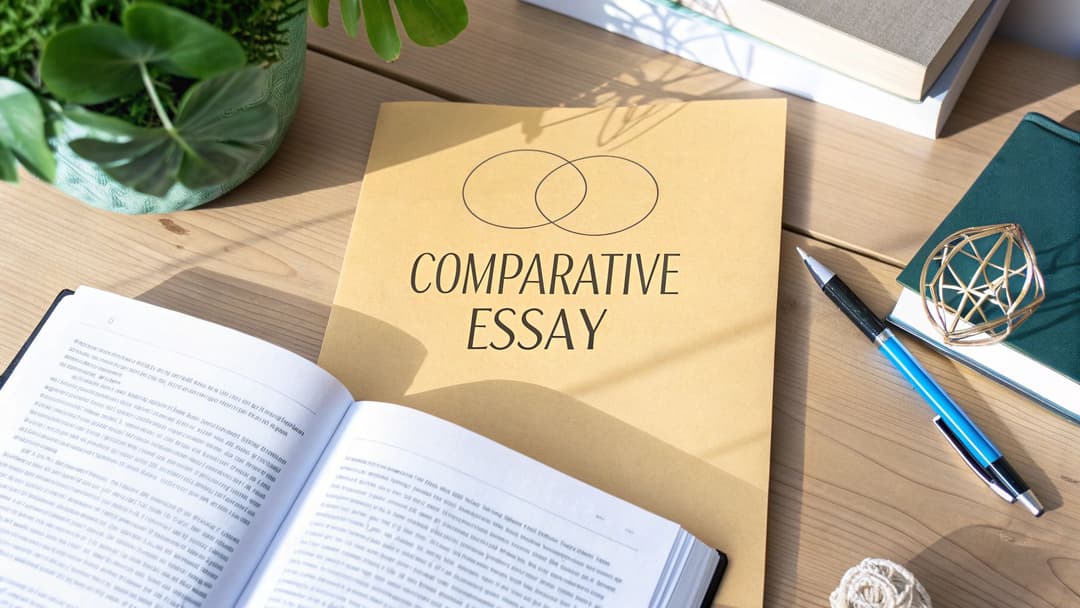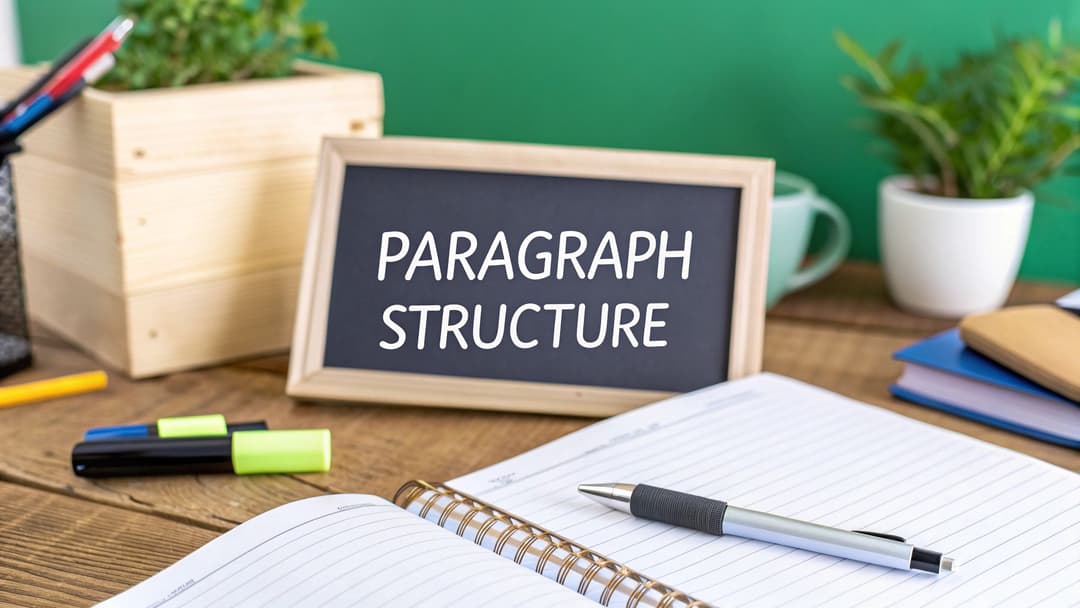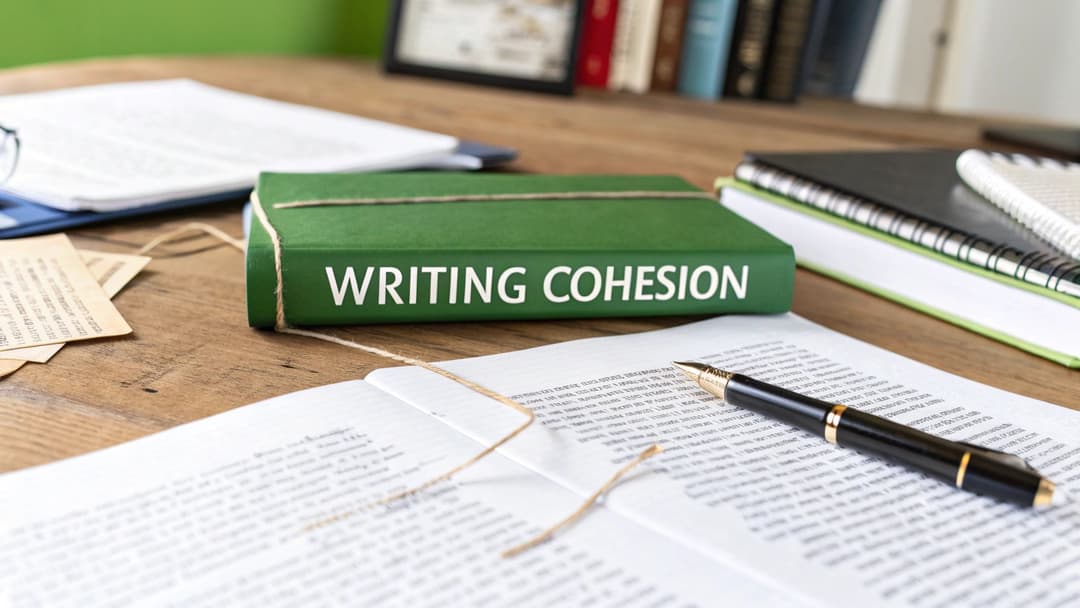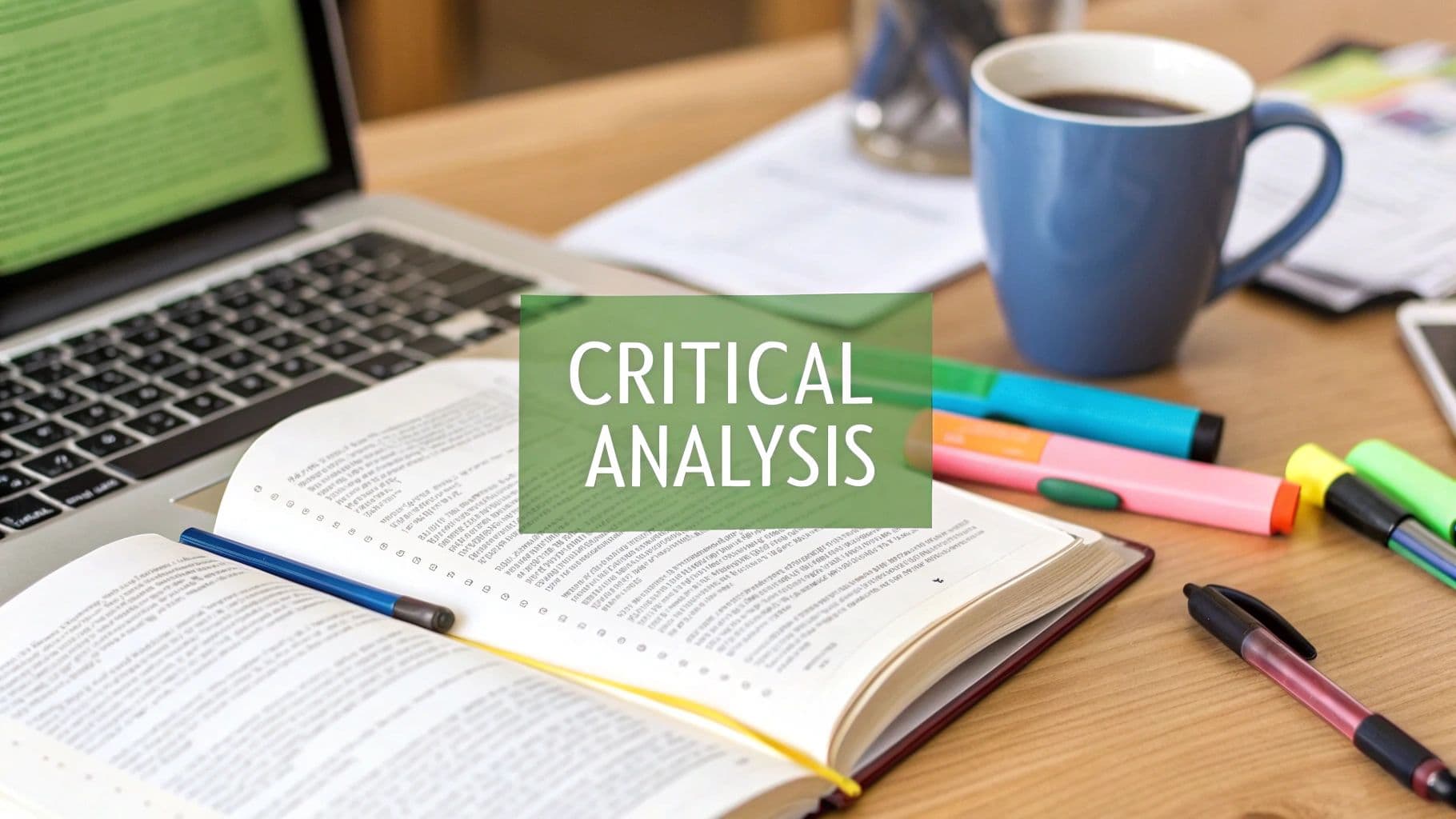
How to Write a Critical Analysis: A Practical Guide
November 27, 2025
Writing a critical analysis isn't just about summarizing what you've read or watched. It's about stepping into a conversation with the material, forming a sharp argument about its strengths and weaknesses, and backing it up with solid evidence.
You're essentially evaluating how effective a work is by questioning its claims, digging into its meaning, and presenting your own well-reasoned perspective. This isn't about nitpicking or finding fault; it's about thoughtful engagement.
What Critical Analysis Really Means
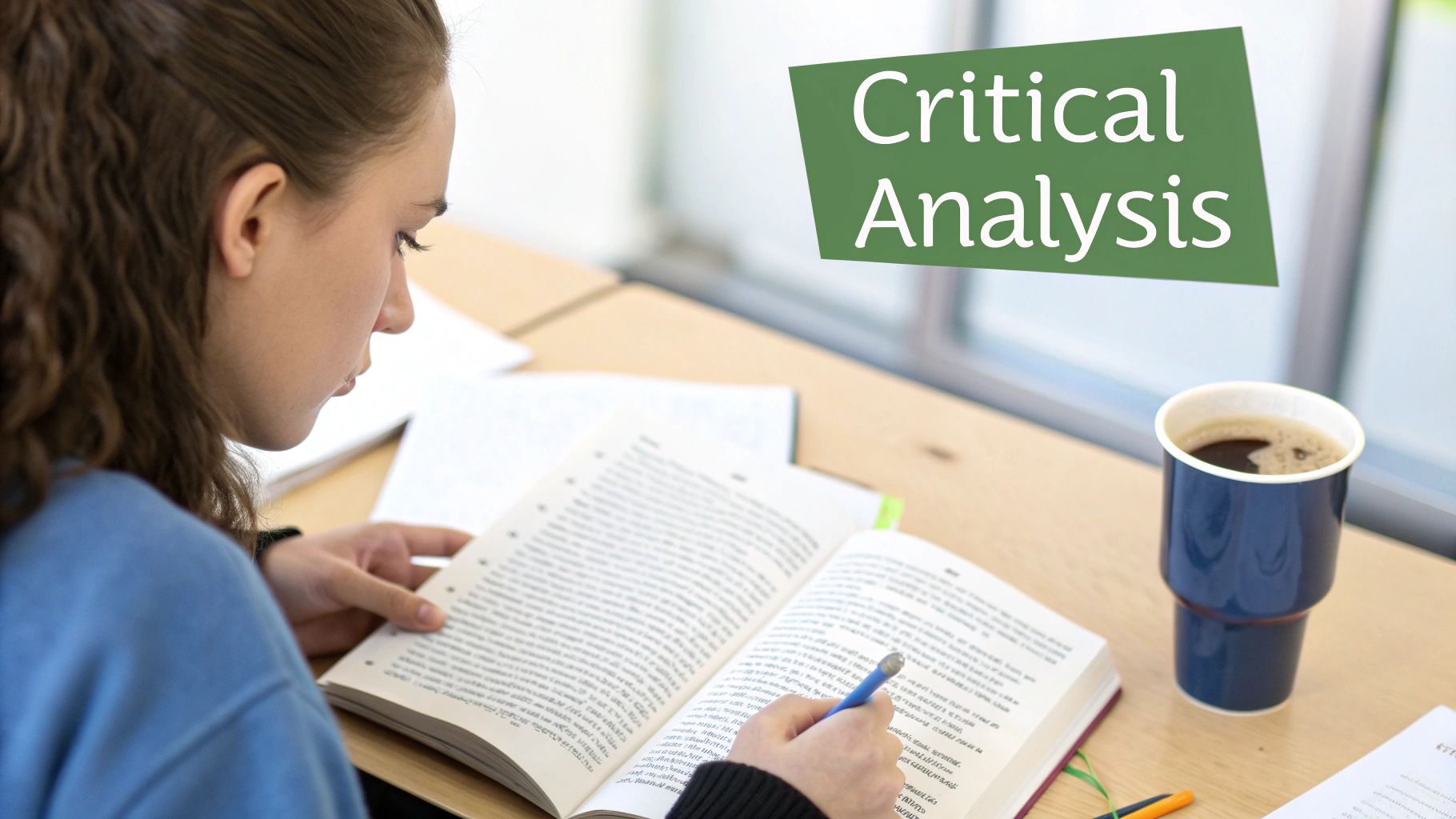
It’s easy to confuse critical analysis with simply stating an opinion. But a real analysis is a disciplined type of argumentative writing where you deconstruct a subject—a book, a film, an article, even a scientific theory—and judge its effectiveness against a clear set of criteria.
Think of yourself as part detective, part judge. First, you gather the clues (the evidence from the text). Then, you build a case (your analysis) that explains what all those clues actually mean.
The goal is to move past saying you "liked" or "disliked" something and start answering much deeper questions:
- How well does the creator achieve their purpose?
- What techniques are they using, and do they work?
- What are the hidden assumptions or biases at play?
- How does this piece fit into a bigger conversation in its field?
Why This Skill Matters Beyond the Classroom
Learning how to write a killer critical analysis pays off long after you've finished the assignment. At its core, this task builds critical thinking, a skill that is absolutely essential in the modern workplace.
It trains your brain to sift through information, question it, spot patterns, and build a logical case—all abilities you need for smart problem-solving in any career.
The demand for this is real. The World Economic Forum's 'Future of Jobs' report consistently names analytical thinking as the single most important skill employers are looking for globally. One study even showed that job postings asking for critical thinking skills shot up by 158% in just a few years.
This table helps clarify the difference between just summarizing and truly analyzing a text.
Critical Analysis vs. Summary at a Glance
| Element | Summary | Critical Analysis |
|---|---|---|
| Purpose | To briefly restate the main ideas of a text. | To evaluate a text's effectiveness and make an argument about it. |
| Focus | What the text says. | How the text works and what it means. |
| Your Role | A neutral reporter of information. | An informed interpreter and judge. |
| Question | "What is this about?" | "Is this effective? Why or why not?" |
| Outcome | An overview or condensed version. | A persuasive argument with evidence. |
Understanding this distinction is the first step. A summary reports, but an analysis argues and persuades.
At its heart, a critical analysis is an evidence-based argument. It’s your chance to demonstrate not just what you know, but how you think. It moves you from being a passive consumer of information to an active participant in an intellectual discussion.
Ultimately, this skill helps you make better-informed decisions, whether you're looking at a business proposal, reading a news article, or developing a marketing strategy. It's a way of engaging with the world more deeply and thoughtfully.
Building the Foundation for Your Argument
A powerful analysis doesn’t start when you begin writing. It starts the moment you engage with the material. Forget just reading—your real goal is to have an active conversation with the text, digging into its arguments, evidence, and all the unsaid assumptions hiding between the lines.
This first phase isn’t about finding quick answers. It’s about learning to ask the right questions and mapping out your own thoughts. Highlighting a few sentences is a start, but it’s not nearly enough. You need a system.
Adopt Active Annotation Strategies
Active annotation is just a fancy way of saying you should write your thoughts all over the text (or a digital copy). As you read, don't just underline things that jump out at you. Turn your observations into notes in the margins.
- Question the author: Why did they make this claim? What are they leaving out?
- Identify key patterns: Notice any recurring images, phrases, or ideas? Jot down where they pop up and what they might mean.
- Challenge assumptions: Does the author just assume you agree with a certain worldview? Flag those moments and question them.
This turns a static document into your personal workspace. Every note you make is a raw ingredient for the argument you’ll eventually build.
Develop a System for Taking Notes
Once you’ve marked up the text, it’s time to bring those scattered thoughts into a more organized space. This is how you translate your gut reactions into a structure that can actually support your analysis.
A simple but surprisingly effective method is the "Claims and Evidence" T-chart. On one side, list the author’s main arguments. On the other, list the specific evidence—quotes, data, scenes—they use to back up each one. This visual layout shows you exactly how the argument is built, and more importantly, where its weak spots are.
The real work of critical analysis happens when you start connecting your observations. Your notes aren't just a summary; they are the start of an original argument. You're looking for the "so what?" behind each piece of evidence.
This focus on argumentative writing is more than just an academic exercise. It's a skill that's been getting a lot more attention globally. In fact, research on these topics ballooned between 1989 and 2021, peaking with 59 articles in 2020 alone. You can dig deeper into the progressive growth of critical analysis research if you’re curious.
Forge a Sharp and Debatable Thesis
Somewhere in your notes and annotations, you’ll start to see tensions, contradictions, or compelling patterns. These are the seeds of your thesis statement. A thesis isn't just a topic—it's the single, debatable claim that will drive your entire paper.
A weak thesis just states the obvious. For example: "Shakespeare's Hamlet is a play about revenge." Sure, it's true. But it gives you nothing to prove.
A strong thesis, on the other hand, offers a specific, arguable interpretation. A much better version might be: "While Hamlet is framed as a revenge tragedy, the play’s central conflict is not Hamlet’s indecision, but his struggle against the corrupting political expectations of the Danish court." Now that's an argument. It's debatable, and it gives your essay a clear mission.
Crafting this one sentence is one of the most crucial parts of learning how to write a strong thesis statement for any analytical paper. Everything else you write will exist to defend this single, powerful idea.
How to Structure a Clear and Persuasive Essay
A brilliant argument can easily fall flat if it’s trapped inside a confusing structure. Think of your essay's structure as a roadmap for your reader—it guides them through your logic, step by step, making your argument feel both natural and inevitable. Without it, even the sharpest insights get lost.
This is where you build the container for your ideas. A solid framework ensures every piece of evidence and every observation directly serves your central thesis, creating a powerful, cohesive whole.
Before you even start outlining, though, the real work happens in your preparation: actively reading the source, pulling out key ideas, and letting those observations shape your main argument.

As you can see, a strong structure is built on a foundation of thoughtful prep work.
The Introduction: Your Hook and Your Map
Your introduction has to do more than just announce your topic. It has three critical jobs: hook the reader, provide essential context, and deliver your clear, debatable thesis statement.
Please, forget generic openers like, "In this essay, I will discuss..." They’re a snoozefest.
Instead, start with a surprising fact, a provocative question, or a compelling quote related to your subject. This initial hook should lead smoothly into a brief overview of the work you're analyzing. Give just enough background—author, title, main purpose—so your reader is grounded, but don't summarize the entire plot.
Finally, stick the landing with your thesis statement at the end of the intro. Placing it here makes it the focal point, signaling to the reader exactly what you intend to prove.
Crafting Cohesive Body Paragraphs
The body of your essay is where you make your case. Each paragraph should act as a mini-argument that supports your main claim. A jumbled mess of paragraphs is the quickest way to lose your reader, so it’s vital to have a consistent structure for each point you make.
A tried-and-true method for this is a simple framework I call T.E.X.T. (Topic Sentence, Evidence, eXplanation, Transition).
This simple structure keeps every paragraph focused, well-supported, and directly tied to your central argument. Here's a quick breakdown:
| The Anatomy of a Critical Analysis Paragraph | ||
|---|---|---|
| Component | Purpose | Example Snippet |
| Topic Sentence | States the paragraph's main point and links it to the thesis. | "The author's use of stark, minimalist settings reinforces the theme of isolation..." |
| Evidence | Provides a specific quote or detail from the source to back it up. | "...as seen when the protagonist describes their apartment as 'a white box with one window.'" |
| eXplanation | This is the analysis part. You explain how the evidence proves the point. | "This description strips the environment of any warmth, mirroring the character's emotional emptiness and detachment from the world." |
| Transition | A concluding sentence that smoothly connects to the next paragraph's idea. | "This sense of physical confinement is further echoed in the story's restrictive social dynamics..." |
Following a consistent structure like T.E.X.T. ensures your essay builds momentum. For a deeper dive into this and other organizational methods, check out our guide on essay structure and examples.
A great critical analysis feels like a well-told story. Each paragraph builds on the last, creating a current that carries the reader effortlessly toward your conclusion.
Writing a Conclusion That Resonates
Your conclusion is your final chance to leave an impression. Its job isn't just to summarize, but to synthesize. Don't just robotically restate your thesis and main points. Instead, show your reader why your analysis actually matters.
Start by revisiting your thesis, but phrase it in a new, more confident way. Then, zoom out. What are the larger implications of your findings? What does your analysis reveal about the work, its creator, or the cultural context it lives in?
You need to answer the "so what?" question. Why was it important to break this work down in this way? A powerful conclusion moves from the specific details you just analyzed to a broader, thought-provoking statement that gives your reader something to chew on long after they've finished reading. It's a skill you can see in action in examples of crafting compelling personal statements and essays.
Using Evidence to Strengthen Your Claims
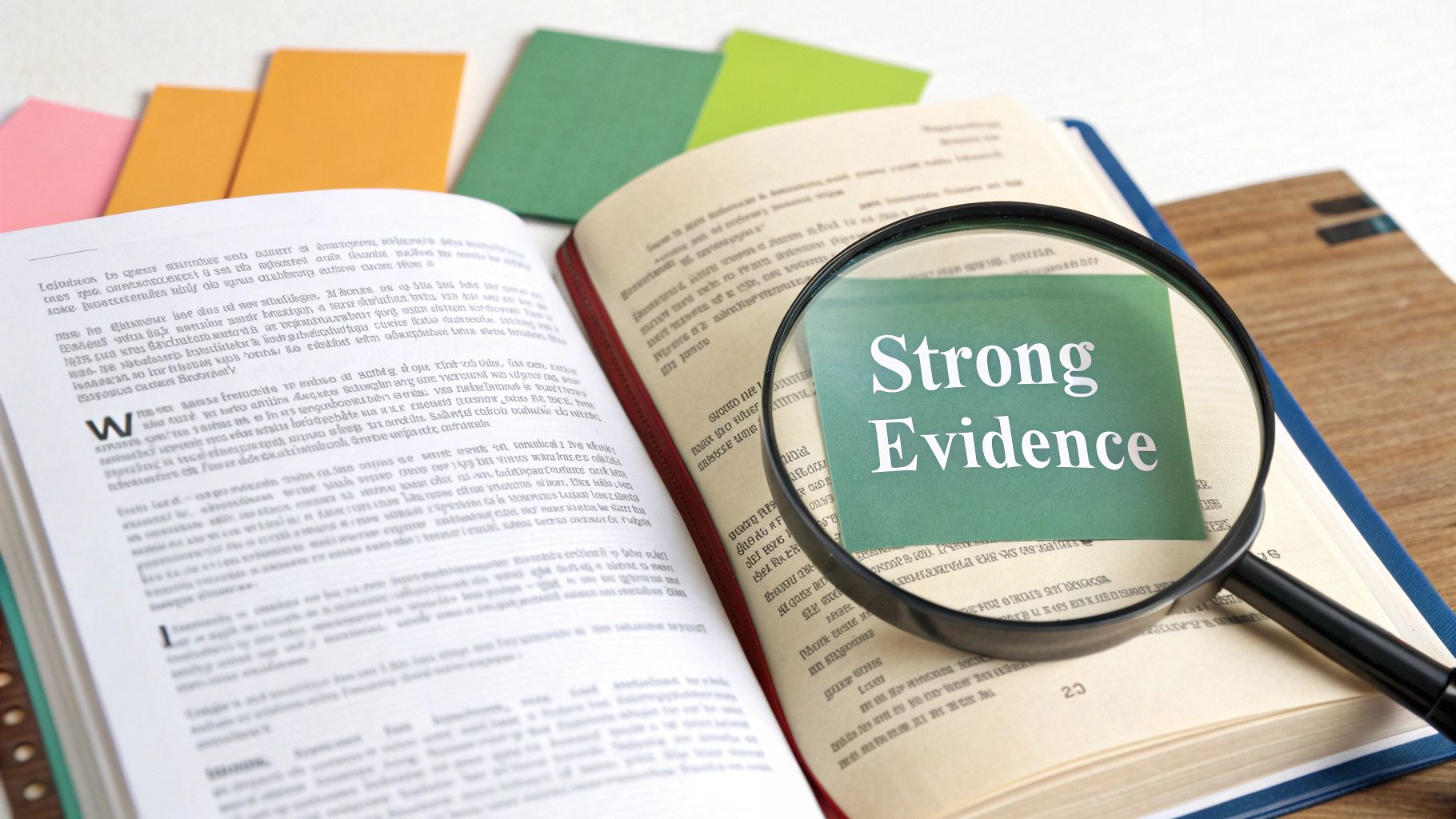
Your analysis is only as strong as the evidence you use to support it. A brilliant thesis can fall apart in a hurry without specific, well-chosen details to back it up. Evidence is the concrete pillar holding up your ideas, giving your argument the weight and credibility it needs to stand on its own.
It's tempting to grab the first quote that seems relevant, but that’s a rookie mistake. The real goal is to find pieces that are not just supportive but also rich enough to unpack. That’s where you get to show off your analytical skills.
Choose Quality Over Quantity
When it comes to evidence, one powerful example is always worth more than five weak ones. Avoid the urge to "quote dump" by stuffing your paragraphs with long block quotes, hoping they'll do the work for you. They won't.
Instead, think like a surgeon. Be precise. Select impactful pieces of evidence that directly and powerfully support the single point you’re making in that paragraph.
So, what does quality evidence actually look like?
- Specificity: Go for details, not generalities. Instead of saying a character is "sad," find a quote where they describe their "hollowed-out feeling" or a scene where their actions betray their inner turmoil.
- Richness: The best evidence has layers. A line of dialogue that reveals character, moves the plot forward, and contains a key metaphor? That's a goldmine for analysis.
- Relevance: This sounds obvious, but your evidence must be laser-focused on the claim you're making right then and there. If your point is about a film's use of color, a quote about the script isn't going to cut it.
The golden rule is this: evidence never speaks for itself. Your job is to be the interpreter who reveals its significance and connects every detail back to your main argument. Dropping a quote without explaining it is like showing a clue to a jury without telling them what it proves.
This interpretive step is what separates a genuine critical analysis from a simple summary. And it’s not just my opinion—educational research confirms that deeply engaging with evidence is what builds a well-rounded argument. You can find more on this in scholarly guides about maintaining criticality in academic writing.
Weave Evidence into Your Writing
Finding the right evidence is step one. Integrating it smoothly is step two. You want your quotes and examples to feel like a natural part of your own sentences, not like they’ve been dropped in from another planet.
The key is context. Never start a sentence with a quote out of the blue. Introduce it. Use a signal phrase to tell the reader who's speaking or what’s happening. This simple trick makes your writing flow so much better.
Let's look at an example analyzing a film scene:
Weak (Dropped Quote):
The director shows the character's isolation. "The camera stays on a wide shot of him sitting alone in the massive, empty warehouse."
Strong (Woven In):
The director visually emphasizes the character's isolation by keeping the camera on a wide shot of him "sitting alone in the massive, empty warehouse," a choice that dwarfs him against his environment.
See how the second example embeds the description into the writer's own analytical sentence? It creates a seamless and much more powerful point.
The Art of Explaining Your Evidence
After you present your evidence, you have to immediately explain it. This is where you answer the "so what?" question. Tell the reader why this piece of evidence matters and how it proves the claim you just made.
To guide your explanation, ask yourself these three quick questions:
- What does this literally show? (A quick clarification)
- Why did the creator choose this specific word or image? (The analysis)
- How does this support my overall thesis? (The connection)
This little mental checklist ensures you're not just summarizing but fully unpacking the evidence. Every quote or example needs at least one or two sentences of your own analysis right after it, linking the detail back to your bigger argument. Honestly, this is the most important part of learning how to write a critical analysis that actually convinces someone.
From First Draft to Polished Final Paper
Hitting 'save' on that first draft feels great, doesn't it? It’s a huge milestone. But think of it as the starting block for the final sprint, not the finish line.
The real magic happens in the revision process. This is where good writing becomes great, and it’s about so much more than just catching typos. It’s a strategic effort to sharpen your argument, tighten your prose, and make your analysis truly land with the reader.
The key is to work from big to small. It's so tempting to dive right in and start fixing commas or swapping out words, but resist. A perfectly polished sentence is useless if the paragraph it's in doesn't actually support your thesis. Nail down the major structural issues first. Get the foundation solid before you start decorating.
Focus on the Big Picture First
Your first pass at revision should feel like you're looking at a blueprint, not the finished building. You’re checking the foundation and the support beams, making sure the whole thing stands up on its own. At this stage, you’re a structural engineer, not an interior decorator.
Ask yourself these high-level questions:
- Is my thesis still sharp? Does the argument I actually wrote match the one I promised in my introduction? Our ideas often evolve as we write, so don't be afraid to tweak your thesis to reflect your strongest points.
- Does every paragraph serve the thesis? Try reading just the topic sentence of each paragraph in order. Do they create a logical, flowing argument? If a paragraph feels like a detour, it either needs to be revised to connect back to the main claim or cut entirely.
- Is my evidence persuasive? Take a hard look at the quotes and examples you used. Are they genuinely the strongest ones you could find? Do they feel woven into your sentences, or are they just dropped in?
This whole phase is about making sure your paper is structurally sound. You’re confirming that your argument holds together and guides the reader clearly from one point to the next.
Revision isn't just proofreading. It's "re-vision"—seeing your work with fresh eyes. The goal is to evaluate the effectiveness of your argument, the clarity of your structure, and the impact of your evidence, long before you worry about individual words.
Refining Your Sentences and Style
Once you’re confident in the structure, you can zoom in. Now it's time to work on the sentence level, where you refine clarity, tighten your language, and make sure your voice is both professional and engaging.
Your goal is to make your writing as clear and impactful as possible, removing any friction for the reader.
Think of it this way: your argument provides the intellectual substance, but your style is the delivery system. Clunky or awkward sentences can obscure even the most brilliant ideas. Research from Harvard Business School even found that problem-solving is often hindered by a failure to clearly diagnose the issue—a principle that applies perfectly to writing. If your sentences are confusing, your reader can't see the solution your argument offers.
To polish your prose, a self-editing checklist is your best friend. Here’s a practical one to get you started:
My Self-Editing Checklist
| Check For | Action to Take | Why It Matters |
|---|---|---|
| Passive Voice | Scan for words like "is," "was," "were," "be." Can you rephrase with a stronger, active verb? | Active voice sounds more direct and confident. It gives your writing energy. |
| Wordiness | Hunt down filler phrases like "due to the fact that" or "in order to." | Cutting fluff makes your sentences clearer and more powerful. Simple is almost always better. |
| Vague Language | Replace words like "things," "stuff," "good," or "interesting" with precise descriptions. | Specificity makes your analysis more credible and your writing more vivid. |
| Repetitive Sentence Starters | Read your work aloud. Do you start too many sentences with "The author..." or "This shows..."? | Varying your sentence structure improves the rhythm of your writing and keeps the reader engaged. |
Using Modern Tools to Polish Your Work
After you’ve done the heavy lifting, modern writing tools can be a huge help for that final polish.
An AI-powered editor like Natural Write can act as a second pair of eyes, catching awkward phrasing or overly complex sentences you might miss after reading your own work a dozen times.
These tools are especially good for humanizing your tone. Sometimes, when we try to sound academic, our writing ends up stiff and robotic. A good tool can help you simplify convoluted sentences and find more natural-sounding words without losing the original meaning. It helps ensure your critical analysis is not just intelligent but also accessible and readable—the final step in transforming your hard work into a truly polished paper.
Common Questions About Writing a Critical Analysis
Even with a great plan, it's easy to get stuck when you're in the middle of writing. That's totally normal. This last section covers some of the most common hurdles we see, with direct answers to get you unstuck and help you finish your paper with confidence.
Think of this as your personal troubleshooting guide. We'll clear up that fuzzy line between personal opinion and supported analysis, nail down the right academic tone, and tackle other practical issues that can make or break your essay.
Is a Critical Analysis Just My Opinion?
This is the number one question, and the answer is a hard no. Your analysis definitely presents your unique perspective, but it's not "just an opinion." An opinion is a personal belief that doesn't need any proof. Saying, "I hated the movie because it was boring," is a classic opinion.
A critical analysis, on the other hand, is an argument built on evidence. You take a stance, but then you defend it with specific details from the work itself. Instead of saying the movie was boring, your analysis would argue something like this: "The film's deliberately slow pacing and sparse dialogue, intended to create a contemplative mood, ultimately alienate the audience by failing to build any real narrative tension."
The difference is proof. An opinion can stand on its own, but a critical analysis needs a foundation of evidence. Your goal is to build such a logical, defensible interpretation that anyone else could read your argument and be persuaded by the evidence you've laid out.
How Do I Know if My Thesis Is Strong Enough?
A weak thesis usually just states an obvious fact or an observation nobody would argue with. A strong thesis, however, makes a specific, debatable claim that needs the rest of the essay to prove it's true.
Not sure about yours? Ask yourself these questions:
- Is it debatable? Could a reasonable person argue the opposite? If not, you’re probably just stating a fact.
- Is it specific? A thesis about "symbolism in the novel" is way too broad. A thesis about how "the recurring symbol of a cracked mirror represents the protagonist's fractured identity" is strong.
- Does it answer "so what?" Does your claim offer a fresh or insightful way of looking at the text?
If you can answer yes to these, you're in good shape.
What Tone Should I Use?
The sweet spot for a critical analysis is a tone that's formal, objective, and confident. You're presenting a carefully reasoned argument, and your language needs to reflect that. Steer clear of casual slang or overly emotional phrasing.
- Be direct. Use an active voice and state your claims without hesitation. Instead of, "It could be argued that..." go with, "The evidence suggests that..."
- Stay objective. Your analysis is about the work, not your personal feelings. Ground every claim in textual evidence, not your gut reactions.
- Avoid contractions and the first person. For the most part, you should avoid "I think" or "I believe." Let your analysis and the evidence you've gathered do the talking for you.
Can I Criticize a Work I Genuinely Like?
Absolutely. In fact, some of the most powerful analyses come from a place of deep appreciation. "Critical," in this context, doesn't mean "negative"—it just means you're engaging in careful, detailed evaluation.
You can analyze a work's strengths just as powerfully as its weaknesses. Learning to articulate why something is so effective is a pretty sophisticated form of analysis. For writers looking to keep growing, exploring online writing courses can sharpen these analytical skills, helping you turn a good draft into a great one.
Crafting a compelling critical analysis is a skill that makes you a sharper thinker and a better writer. As you put the finishing touches on your draft, a tool like Natural Write can be a huge help. It can humanize your tone, untangle complex sentences, and make sure your arguments land with clarity and force—all without watering down your original ideas. You can bypass AI detectors and present your work with the confidence it deserves.
